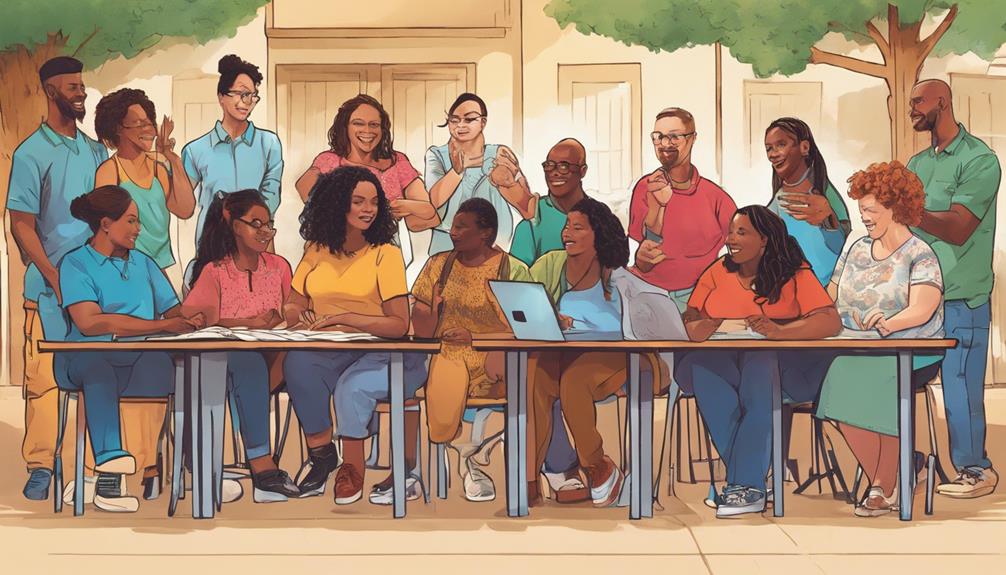When we use American Sign Language to sign 'Happy Birthday,' our goal is to express our heartfelt wishes in a significant manner. Grasping the signs used in this phrase is merely the starting point; it’s the subtle differences and alterations that enrich the conveyed message.
Whether you're new to ASL or looking to enhance your signing skills, exploring the intricacies of signing 'Happy Birthday' can open up a world of possibilities for expressing joy and celebration.
Key Takeaways
- Signing 'Happy Birthday' in ASL fosters inclusivity and understanding.
- Hand gestures symbolize celebrating joyfully with Deaf individuals.
- Practice improves signing proficiency for special occasions.
- Using sign language shows respect and enhances connections in celebrations.
Importance of Sign Language in Celebrations
Signing 'Happy Birthday' in American Sign Language (ASL) at celebratory events enhances the inclusivity and personal connection shared with Deaf individuals. By incorporating sign language into birthday greetings, we show respect for Deaf culture and create a more meaningful celebration. Learning how to sign birthday wishes in ASL not only demonstrates an appreciation for diversity but also highlights different modes of communication, fostering an environment of understanding and inclusivity.
When we use ASL to convey birthday wishes, we not only make the event more accessible to Deaf individuals but also showcase our willingness to embrace various forms of expression. Sign language provides a creative and expressive way to communicate well wishes and celebrate special occasions, making the moment more heartfelt and engaging for everyone involved. Through the simple act of learning how to sign 'Happy Birthday,' we can make a significant impact on the inclusivity and warmth of celebratory gatherings.
Steps to Sign 'Happy Birthday' in ASL

To effectively convey birthday wishes in American Sign Language (ASL), understanding the specific steps to sign 'Happy Birthday' is crucial. In ASL, sign 'happy' by bringing a flat hand up to your chest twice, and sign 'birthday' by using the bent middle finger of your dominant hand from chin to chest. Combining these two signs creates the phrase 'Happy Birthday' in ASL. It's important to note that there may be regional variations in how 'Happy Birthday' is signed in ASL, so it's beneficial to be aware of these differences when communicating. Additionally, to make birthday messages more personal, consider incorporating name signs or fingerspelling in ASL.
| Step | Action |
|---|---|
| 1. Sign 'Happy' | Bring a flat hand up to your chest twice. |
| 2. Sign 'Birthday' | Use the bent middle finger of your dominant hand from chin to chest. |
| 3. Combine Signs | Merge the signs for 'Happy' and 'Birthday' for 'Happy Birthday' in ASL. |
Hand Gestures for 'Happy Birthday' Sign
Let's explore the hand gestures used to express 'Happy Birthday' in American Sign Language (ASL).
To sign 'Happy Birthday,' move the bent middle finger of your dominant hand from your chin to your chest. This gesture is a common way to convey birthday wishes in ASL, symbolizing the celebration of someone's birth with joy.
Learning this sign enables you to participate in birthday festivities with Deaf individuals, fostering inclusivity and connection.
Practicing the 'Happy Birthday' sign will enhance your proficiency in using ASL for special occasions, allowing you to communicate effectively and share in the excitement of birthdays.
Practice Tips for Fluent Signing

Moving beyond basic hand gestures, honing our signing skills involves consistent practice and diverse learning approaches to achieve fluency in American Sign Language. Fingerspelling practice is essential for improving speed and accuracy when signing words and names.
Utilizing resources such as online ASL dictionaries and videos can help expand vocabulary and learn new signs. Engaging in conversations with Deaf individuals or fluent signers provides valuable exposure to ASL nuances and enhances fluency.
Attending ASL classes or workshops offers structured environments for practice and feedback from instructors. Setting specific goals for signing practice sessions is crucial for tracking progress and staying motivated in the learning process.
Sharing the Joy: Using Sign Language
Using sign language in celebrations like birthdays not only enhances inclusivity but also fosters deeper connections with the Deaf community. Incorporating sign language adds a personal touch and shows respect for Deaf culture.
Here are some ways using sign language can help share the joy in celebrations:
- Conveying Warmth: Signing 'Happy Birthday' in ASL can convey warmth and inclusivity to Deaf individuals, making them feel appreciated and included in the celebration.
- Promoting Cultural Understanding: Learning to sign 'Happy Birthday' promotes cultural understanding and respect for the Deaf community, fostering a more inclusive environment.
- Creating Meaningful Connections: Incorporating sign language in celebrations like birthdays can create meaningful connections with Deaf friends and family, strengthening relationships and communication.
- Demonstrating Commitment: Using ASL for special occasions like birthdays demonstrates a commitment to accessibility and diversity, showcasing a willingness to embrace different forms of communication.
Frequently Asked Questions
What Is the Sign for Happy Birthday in Asl?
We can help you understand the ASL sign for 'Happy Birthday.' It involves combining the signs for 'happy' and 'birthday' in a fluid motion.
Learning this sign allows you to convey warm wishes and connect with Deaf individuals on special occasions. Mastering it adds a personal touch to birthday celebrations.
How Do You Say My Birthday in Sign Language?
We tap our chests to fingerspell 'MY' and make a circular motion from chin to chest with the bent middle finger for 'BIRTHDAY' in American Sign Language.
Combining these signs conveys 'My Birthday' in ASL.
Learning to sign this phrase helps us express personal celebrations and connect with Deaf individuals.
How Do You Say Happy Birthday in Baby Language?
We've found that using baby language to express 'Happy Birthday' can be a delightful way to engage with little ones. It fosters early communication skills and strengthens the parent-child bond.
Repetition and positive reinforcement are key in teaching babies this sign. It's heartwarming to witness their excitement when they master it.
Learning baby sign language not only aids in expression but also brings joy to special occasions.
What Is the Sign for Happy in Asl?
We often express happiness in American Sign Language by bringing both hands up to our chests and moving them outward twice.
This dynamic gesture combines signs for 'content' or 'pleased' with 'emotion' or 'feeling happy.'
The sign for 'happy' in ASL is vibrant and conveys positive emotions effectively.
Learning this sign is crucial for expressing various positive feelings and enhancing non-verbal communication of joy and happiness.
Conclusion
In conclusion, learning how to sign 'Happy Birthday' in ASL is a meaningful way to celebrate loved ones.
Did you know that American Sign Language is the third most-used language in the United States?
By incorporating sign language into our celebrations, we can make them more inclusive and special for everyone involved.
Keep practicing and spreading joy through sign language!










